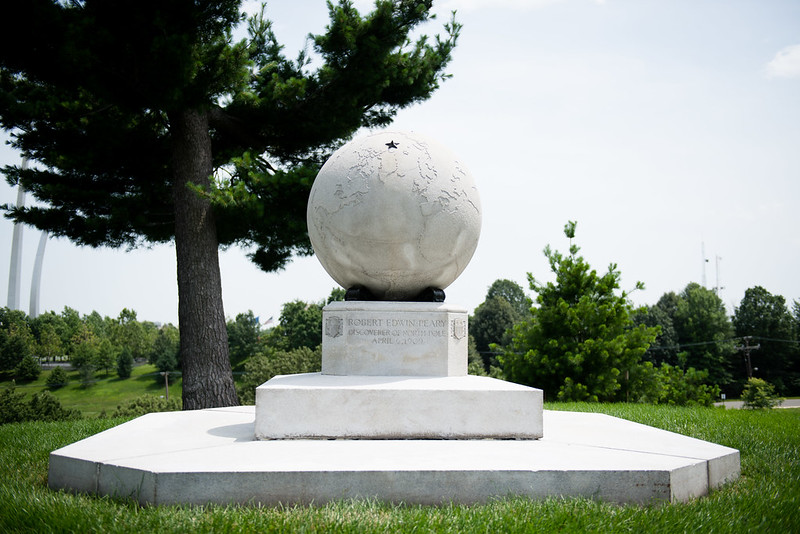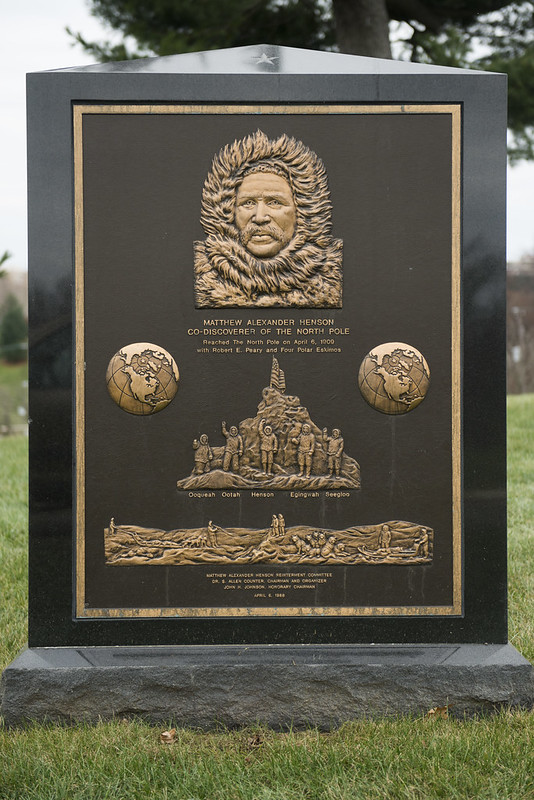
Floyd Bennett, U.S. Navy (1890-1928) — According to their own accounts, pioneering naval aviator Floyd Bennett and Adm. Richard E. Byrd accomplished the first flight over the North Pole on May 9, 1926. Piloting a Fokker Tri-motor, Bennett took off from the Norwegian Arctic island of Spitsbergen, crossed the pole and returned 16 hours later. Although some have contended that Bennett and Byrd did not make it all the way to the North Pole, the flight — 1,545 miles amid extremely strong winds — was nonetheless a significant accomplishment. Along with Byrd, Bennett received the Medal of Honor for the flight, and he became the namesake of New York's first municipal airport, Floyd Bennett Field. (Section 3, Grave 1852-B)
Richard Byrd, U.S. Navy (1888-1957) — An Arctic explorer and naval aviator, Byrd was the first person to fly over both poles of the Earth. On May 9, 1926, in a Fokker Tri-motor piloted by Floyd Bennett, he traversed the North Pole in a 16-hour flight over 1,545 miles. Along with Bennett, he received the Medal of Honor in recognition of his accomplishment. He made expeditions to Antarctica during the late 1920s and 1930s, achieving the first flight to and from the South Pole on November 28, 1929. The following month, Congress promoted him to rear admiral (retired). Byrd continued exploring Anarctica throughout his life; he was 67 years old at the time of his last expedition, in 1955. (Section 2, Grave 4969)
Adolphus W. Greely, U.S. Army (1844-1935) — Greely was a career U.S. Army officer and Arctic explorer. During the Civil War, he commanded the 81st Regiment, United States Colored Infantry. Greely spent most of his Army career with the Signal Corps, supervising the construction of telegraph lines, conducting meteorological research and helping to establish the Weather Bureau. From 1881 to 1884, he led an expedition to the Arctic Circle, surviving two Arctic winters without being resupplied. Greely then returned to his work with the Signal Corps, and in 1887 President Grover Cleveland promoted him to brigadier general and chief signal officer. After retiring, he co-founded the National Geographic Society. On March 27, 1935, his 91st birthday, he was awarded the Medal of Honor. (Section 1, Grave 129)
 Matthew Henson (1886-1955) — With Robert E. Peary, Matthew Henson reached the North Pole on April 6, 1909. Born to Black sharecropper parents in Maryland, he was orphaned at a young age and spent six years at sea as a cabin boy. While working as a shop clerk in Washington, D.C., he met Peary, who hired him as an assistant on an expedition to Nicaragua. Between 1891 and 1909, Henson and Peary conducted seven Arctic expeditions, chronicled in Henson's 1912 book, "A Negro Explorer at the North Pole." Henson was originally buried at New York's Woodlawn Cemetery, but in 1988 President Ronald Reagan authorized his reinterment at Arlington next to Peary. (Section 8, Grave S-15-1)
Matthew Henson (1886-1955) — With Robert E. Peary, Matthew Henson reached the North Pole on April 6, 1909. Born to Black sharecropper parents in Maryland, he was orphaned at a young age and spent six years at sea as a cabin boy. While working as a shop clerk in Washington, D.C., he met Peary, who hired him as an assistant on an expedition to Nicaragua. Between 1891 and 1909, Henson and Peary conducted seven Arctic expeditions, chronicled in Henson's 1912 book, "A Negro Explorer at the North Pole." Henson was originally buried at New York's Woodlawn Cemetery, but in 1988 President Ronald Reagan authorized his reinterment at Arlington next to Peary. (Section 8, Grave S-15-1)
Robert Edwin Peary, U.S. Navy (1856-1920) — On April 6, 1909, Robert Peary led what was reported as the first successful expedition to the North Pole, joined by his colleague Matthew Henson and four Inuit assistants. While in the U.S. Navy Civil Engineering Corps, Peary had made several previous Arctic expeditions, setting a "farthest north" record — for which he received the National Geographic Society's Hubbard Medal — on a Greenland expedition in 1906. In 1911, Congress promoted Peary to rear admiral. The monument over his grave (pictured, above) features a large, white granite globe, with a bronze star marking the North Pole. (Section 8, Grave S-15)
John Wesley Powell, U.S. Army (1834-1902) — An explorer, geologist and ethnologist, Powell is best known for his Colorado River and Grand Canyon explorations of 1869-1871. From 1881 to 1894, he directed the U.S. Geological Survey, and in 1879 he received a second appointment as the first director of the Smithsonian Institution's Bureau of Ethnology. He also helped to establish the National Geographic Society, the Geological Society of America and numerous scientific organizations in Washington, D.C. Powell fought in the U.S. Army during the Civil War, losing his lower right arm in the Battle of Shiloh. (Section 1, Grave 408)
Finn Ronne, U.S. Navy (1899-1980), Edith "Jackie" Maslin Ronne (1919-2009) — Born in Norway, U.S. Navy Captain Finn Ronne made nine expeditions to Antarctica. Ronne discovered and mapped areas that include the massive Ronne Ice Shelf, the world's second-largest body of floating ice. Ronne originally named it "Edith Ronne Land," after his wife, Edith "Jackie" Maslin Ronne, a fellow explorer. In 1971, Finn and Jackie Ronne became the first married couple to fly to the South Pole. They are buried together at Arlington. (Section 2, Grave 4957)
Elmer F. Stone, U.S. Coast Guard (1887-1936) — The U.S. Coast Guard's first aviator, Coast Guard Academy graduate Elmer Stone flew seaplanes for the U.S. Navy during World War I and advocated for the development of Coast Guard aviation. In May 1919, he piloted the first successful flight across the Atlantic Ocean, a 54-hour feat via Nova Scotia and the Azores. (Eight years later, Charles Lindbergh would accomplish the first non-stop transatlantic flight.) During the 1920s and 1930s, Cmdr. Stone tested new types of seaplanes for the Coast Guard and Navy, and in 1934 set a world speed record for amphibian aircraft. He died of a heart attack while on duty on May 26, 1936. (Section 4, Grave 3205-A)
Charles Wilkes, U.S. Navy (1798-1877) — Charles Wilkes was a U.S. Navy officer, Civil War veteran and explorer. Known for his skill with navigational instruments, he commanded the U.S. Exploring Expedition of 1838-1842 (also known as the Ex. Ex. or Wilkes Expedition), which mapped large portions of the northwest American coast, the Pacific and Antarctica. The expedition confirmed that Antarctica is a separate continent, and established U.S. naval power in the southern and eastern Pacific. Wilkes's Civil War service was controversial, resulting in an 1864 court martial; however, the charges were dropped and he was promoted to rear admiral (retired) in 1866. (Section 2, Grave 1164)
See also: